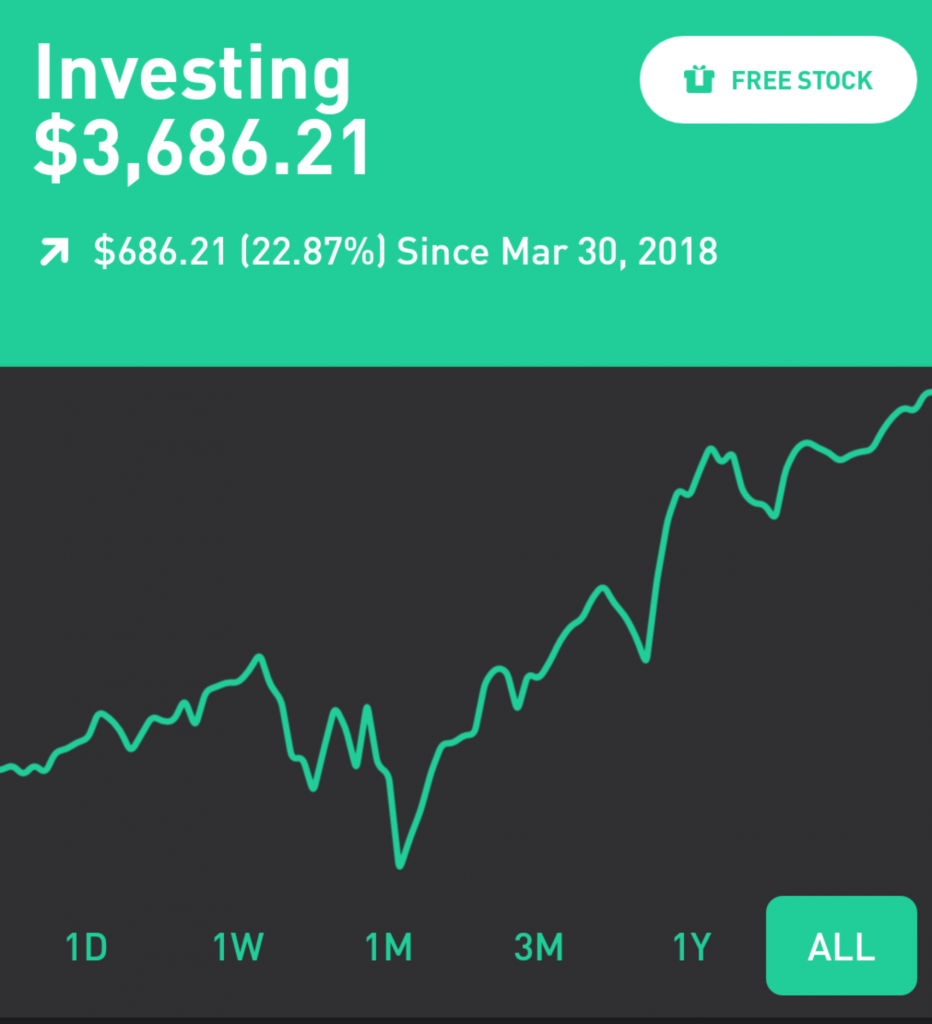
Almost two years ago I threw a bit of money into Robinhood to learn a bit about the stock market. At the time, they were the only major company offering free trades, and now, my primary broker (Schwab) offers that feature as well as many others. And during that time I managed to beat the market, which is great, new career as a trader!
Or not, as I shall explain shortly, I have decided that managing a portfolio in a high-maintenance way isn’t worth it even if I could, maybe, sometimes, beat the market by a little.
SP500 percent change of 19.4%. SP500 April 2, 2019 open: 2,633.45 and SP5000 December 6, 2019, close: 3,145.91
That compares to my portfolio percent change of 22.9%. Starting value of $3000, ending value $3686.21.
Here is my final portfolio, with value changes
| Ticker | Name | % Change | $ Change |
| GE | General Electric | -14.8% | $ (5.79) |
| VMM | Minnesota Bonds | 1.6% | $ 1.00 |
| KMB | Kimberly Clark | 29.7% | $ 62.71 |
| MSFT | Microsoft | 64.2% | $ 59.31 |
| SCHD | Schwab High Dividend | 17.0% | $ 66.72 |
| VIG | Vanguard Dividend | 21.9% | $ 242.42 |
| GLD | SPDR Gold | 9.1% | $ 11.56 |
| REMX | Vaneck Rare Earth | -54.9% | $ (30.92) |
| F | Ford Motor | -20.5% | $ (69.79) |
| OMI | Owens and Minor | 53.7% | $ 26.19 |
| PBW | Clean Energy Fund | 21.7% | $ 5.56 |
| WMT | Walmart | 44.9% | $ 111.42 |
| CRM | Salesforce (ex Tableau) | 36.1% | $ 315.98 |
| ZNGA | Zygna Gaming | – | $ 6.24 |
| $ 796.37 | |||
| Earlier losses, approximately | $ (250.00) | ||
| Dividends (about 1.75%/year) | $ 119.16 |
One Strategy of Success:
Buy stock which has fallen sharply, due to unfavorable press. Usually it is undervalued for a short time after.
Colin Catlin
Most of my wins fall into this category. They had recently dipped appreciably due to bad news or a a quarter’s missed earning expectations. This included Microsoft, OMI, Walmart, Amazon (in Schwab, not here) and Kimberly Clark. Nor is this strategy unique to me, when I have heard others mention good stock purchases, they often seem to fall into this category.
Notable failures of this strategy are: GE, Ford. These two are significant as they have clear longer term problems, a dip rarely recovers, whereas Walmart, Microsoft, and company appear to have bright outlooks as far as can be seen. So perhaps there should be a caveat – buy companies which have had a flurry of recent bad press, but in the longer term have had generally favorable outlooks.
I have some hypotheses about why this strategy can be effective. My favorite is this: this is a really hard strategy to automate (so hard for big funds to utilize and thus us remove the opportunities). Perhaps you could use sentiment analysis, and buy stock with strong negative recent sentiment, but long-term positive sentiment. But sentiment analysis in reality is messy, and the much more difficult question of – when to sell? – is also very unclear as some negative press results in a very short dip, and others in much longer ones. Furthermore, it is a rather hard strategy to implement for more normal people – these opportunities come at erratic times, and requires keeping a close eye on the news, and willing to make quick trades against societal opinion. Many people will be more emotionally overwhelmed by a short term plummet in public opinion about a company, and will have a harder time considering short vs. long term value in the face of emotional news content. What if this really is the collapse of the Amazon/Google/etc pipe dream??? They wonder…
Basically this strategy is to profit on the emotional fickleness of the masses while you sit in your lofty tower of rationality, cackling madly to yourself.
At least that’s what I do.
It’s Too Much Work and Stress to do at Scale
I found myself not making trades that often. Life has plenty of other things for us to do. While trading a few thousand dollars can be done without great emotional terror, doing the same with all your life’s savings is another story. Maintaining a diverse portfolio is an even bigger challenge, as there are lot more stocks then to keep an eye on.
While it might be possible to beat the market consistently by a few percent, is it worth the stress and uncertainty, when an index fund can follow the market much more comfortably?
Robinhood was a good, functional tool. They make it simple to trade and experiment, but they lack the functionality I would want to see for a much larger investing scale. I do like well-designed phone apps (Schwab could use some work here). They make it easy to check up, and receive notifications. At the end of the day it was one app too many to manage taxes for.
Future Plans
- 60% of Money in Index and Mutual Funds
- 20% Tax-Free Bonds
- 10% Opportunistic Trading like above
- 10% Cash (ideally in high-yield savings)
- Preference for stocks/funds that pay dividends. Walmart & Microsoft, above, paid good dividends as well as growing a lot – definitely my best choices.
This was officially my first click-bait-y title, mostly for my own personal amusement. Hope you were amused too.
